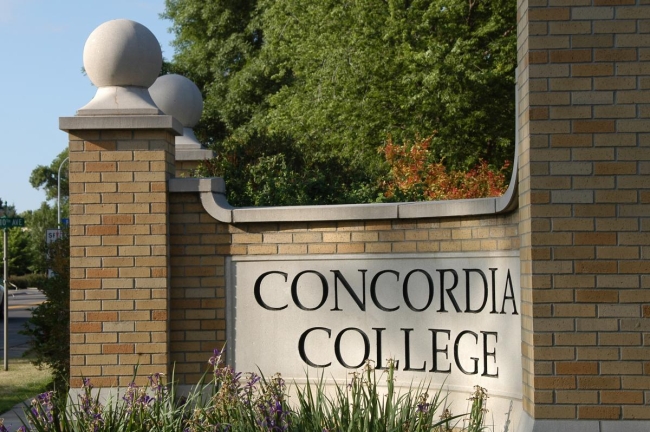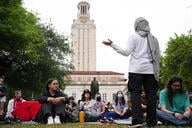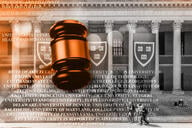You have /5 articles left.
Sign up for a free account or log in.

Concordia College
Students who have made efforts to change the racial dynamics at Concordia College are worried their reports of racist incidents on campus are falling on deaf ears as concerns about a white professor who used a racial slur during class have been met largely with silence.
That incident and others were referenced during a student government forum held last month on Martin Luther King Jr. Day for students of color to share experiences of “hardships, difficult situations and oppression” at the Lutheran liberal arts college in Moorhead, Minn. The students are frustrated with how race is discussed on the largely white campus and how administrators have handled past incidents of racism. They say when reports are made to the college's Bias Incident and Response Team, or BIRT, the default response by administrators is to send out a standard email, according to notes from the student government forum.
"The BIRT is here to receive, review, and assess reports of bias, and where necessary, forward the report to the appropriate investigating and sanctioning office on campus," said one such response. "BIRT does not have investigative or sanctioning authority. The BIRT is now in the process of reviewing and discussing your report."
The student activists say such cut-and-paste responses are unacceptable, insensitive and do little to address the problems or bridge racial divides on a campus that is 82 percent white.
“Students want to have these conversations and want to be heard,” said a white student who is involved in several campus governance groups and did not want to be identified. “It’s almost like gaslighting. We’re told that they want us to talk about this, then [we are] not heard.”
The incident involving the professor who used the racial slur was reported multiple times to the BIRT and raised repeatedly at the forum. Richard Chapman, who is also chairman of the history department, wrote the N-word on a board and said it multiple times during a class exercise in which students were asked to write terms describing both light- and dark-skinned people on opposite sides of a board, said Sutton Junkermeier, a white sophomore who took the course. When no student had written or referenced the slur by the end of the activity, Chapman took it upon himself to write and say it, said Paige Mackedanz, another student in the class.
Students in the class, including two black students, some of whom were visibly uncomfortable, did not respond. They didn't see much “academic purpose” in referencing the slur, Junkermeier said.
One of the black students subsequently dropped the course, leaving Anita Ukpokolo as the sole student of color in the class. Ukpokolo said she went to each following class with “a bit of a grudge.” She said the rest of the course felt like a “disservice” to her white classmates, because Chapman was teaching black history without putting it in the context of today's racial climate, which Ukpokolo said could have been enlightening.
“He can talk about what he observed, but he’s never felt it," Ukpokolo, a junior, said of Chapman's expertise on black history. "Any part of history or connection of the history that he’s talking about, I just don’t think he can rightfully stand up and say he’s the best person in the room to have knowledge on the subject.”
A handful of students at the January forum wondered aloud whether Chapman should be instructing the course.
“A white man should not be teaching black history,” said one student, according to notes taken by the SGA. “If they don't have a person who is representative of the class, don't teach it.”
Chapman has since apologized for using the racial slur and recently tried to explain his actions. In a letter to the editor he wrote last week to The Concordian, the student-run newspaper, he said he was “simply mistaken to invite discussion of the ‘N-word’ at that moment.”
"What happened back in late August? In short: a discussion about racial language and terminology that turned to use of the 'N-word,' a subject that I introduced into the conversation," Chapman wrote. "Right place, wrong time, wrong way … I have since thought long and hard about that discussion from the standpoint of my position as a white male professor. Here’s the thing: what may be academic to some -- a matter of history -- is lethal and ever-present to others -- not past at all."
Days after the incident in his black history class, Chapman invited his students to a meeting with the college's chief diversity officer, Edward Antonio, where Chapman formally apologized for using the racial slur. Chapman also resigned from his position as chairman of the college president's Diversity Council around the same time, according to his Concordian editorial.
“I am grieved by the hurt and damage done and want to express my sincerest apologies,” Chapman wrote in an email inviting the students to the meeting. “I am truly sorry and seek your forbearance and forgiveness.”
Ukpokolo and Mackedanz, a white student, said the professor seemed to talk around his use of the racial slur during the meeting, instead of addressing it outright.
“I don’t really remember him saying, ‘I said this, that was wrong, I’m sorry,’” Mackedanz said. “He used a lot of academic language to dance around what happened.”
Junkermeier said there was "something of the sort" of an apology during the meeting. As a white student majoring in education, he said he was able to give Chapman the benefit of the doubt and tried to see the educational reasons for using the term.
"I wouldn’t say that he should lose his job or stop teaching the class, but I would advise him to be more careful with the lessons and to plan ahead."
Mackedanz attended the student government forum in January and said she felt compelled to file a report about Chapman to the BIRT afterward because of the continued impact the incident had on students of color across the college. She believed filing the report might prompt more investigation of the incident or conversations between the Office of Diversity and students of color about a possible resolution.
What resulted was an emailed reply from Antonio, saying the BIRT is "here to provide you with direction towards resources you might need as you think through and process your experience" and informing her that the office was already aware of the incident. He offered to meet with Mackedanz, and she took him up on the offer but never heard back.
When a video surfaced on social media in May 2019 depicting a Concordia student using racial epithets and white supremacist gestures, Antonio told INFORUM, a local news service, that Concordia "was aware of the video and was working to 'address the matter.'" But it was "not exactly clear what action the college is taking with the student," INFORUM reported.
Antonio did not reply to requests for comment. Amy Kelly, Concordia's communications director, acknowledged the incident with Chapman in a statement from the college but declined to provide any additional details about how the matter was handled.
“Given the important and sensitive nature of the situation, the college conducted an official review,” Kelly wrote in an email. “The process followed standard college policies and procedures. While the individual course and instructor are now a matter of public record, the college cannot speak publicly regarding personnel matters.”
Mackedanz said her experience was reflective of how Concordia typically handles racial bias incidents -- “they don’t handle it at all.”
“It’s swept under the rug,” she said. “Things happen and nothing comes out of it, even when students raise their voices and go through the proper channels. It doesn’t seem like that system is working, so how can we change that?”
Ukpokolo said when the incident first happened, she wrote a report to the BIRT but never sent it because she was “doubtful that it would do anything.”
“I didn’t really believe in the process,” Ukpokolo said.
Chapman’s apology has not been enough for students of color to look past the college’s tendency to “sweep incidents of bias under the rug while pretending to be champions in advancing and advocating for the need of literacy and action in issues of diversity,” said an international student who has been involved in several campus governance groups and did not want to be identified. Students who have voiced their frustrations about bias incidents have been met with “no acknowledgment whatsoever,” the student said.
This student and the other student who did not want to be named said they were frustrated with going through the proper channels to report bias incidents and seek redress by the college, only to have their concerns ignored.
Josh Lysne, assistant vice president for communications, said reports of bias incidents are not being ignored.
The college sends a “standard acknowledgement email” to those who submit bias reports, he said in a written statement. The sender is contacted, offered support and encouraged to share more details if they want to, but the “specific outcomes of these reports are not made public,” he said.
“As a matter of best practice and concern for personal confidentiality, the college does not publicly respond to official reports of bias submitted to the college,” Lysne said. “The college recognizes some may criticize this practice for lack of transparency.”
Students also referenced to two separate occasions in 2017 and 2018 when “It’s OK to be white” posters were anonymously plastered all over the campus. Although the posters were removed, about 500 students -- a quarter of the undergraduates enrolled at the time -- protested in 2018, one of the students who did not want to be named recalled. William Craft, Concordia's president, responded to the 2017 incident by publishing a lengthy statement to the college’s Facebook page, encouraging “open conversation about the experience of race on this campus and beyond.”
Students said they have not yet seen evidence or results of these conversations.
“Any attempt to address students of color’s campus issues has usually been the campus trying to cover their asses and make sure they have something they can reference to say we’ve taken action on this issue,” Ukpokolo said. “This college is relatively new to this element of diversity. It takes a long time for it to stick and become part of the culture.”




